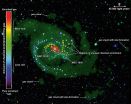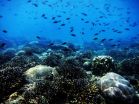(Press-News.org) Qatar's capital city, Doha, is set to emerge as a major knowledge hub, with its educated, high-tech workforce and its international connectivity. However, the lack of a cohesive plan for development and the mobility of that workforce in and out of Qatar could stymie its success on the global stage.
The rulers of the Arab state of Qatar have shaped their capital city, Doha, into one of the fastest-growing cities in the world and also, through economic diversification and other measures, establishing it as a significant hub city in the global knowledge economy. Research published in the International Journal of Knowledge-Based Development suggests that the ascendency of Doha, the notion of the Oryx taking off, is emerging because of the relational economic geography and the physical urban development in the city.
Sven Conventz of TU Munich and colleagues there and at Frankfurt University of Applied Sciences, Germany and the University of Strathclyde, UK, explain how the Oryx antelope, logo of Qatar Airways, provides a neat metaphor for the rise of Doha in the Gulf region. Whereas Dubai and Abu Dhabi have become rather famous in the global theatre, Qatar's capital attracted little international attention until recently despite rapid urban. Its fossil fuels, progressive governance - since 1995 - and its advantageous geopolitical location could change that to Doha's and Qatar's benefit.
The team has investigated the notion of "when the Oryx takes off" and found that knowledge intensive Qatari firms in the Gulf region play an important role. However, the airline connectivity between Qatar, Europe and South-East Asia is equally important. Conversely, there is, they report, a distinct lack of urban amenities for knowledge workers and if this problem is not addressed, the Oryx may never fly as high as the state's rulers hope.
"Today knowledge is considered a key driver for innovation, economic growth and spatial development," the team asserts. However, we still lack a fully accepted definition of what the knowledge economy exactly is. Nevertheless, it certainly encompasses advanced producer services (APSs), high-tech industries and knowledge-creating institutions, such as universities and research establishments. "Large-scale public investments initiated by Qatar's rulers have shaped contemporary Doha into one of the fastest growing cities in the world and a serious contender as an emerging regional hub city," the team says. This is happening despite the lack of a cohesive development vision or plan, their findings suggest, and the ever-changing composition of Qatar's society might ultimately ground the Oryx unless there is long-term commitment from the highly educated workforce to stay and to develop a functioning, self-contained service economy.
INFORMATION:
Conventz, S., Thierstein, A., Wiedmann, F. and Salama, A.M. (2015) 'When the Oryx takes off: Doha a new rising knowledge hub in the gulf region?', Int. J. Knowledge-Based Development, Vol. 6, No. 1, pp.65-82.
Patients with insulin-dependent diabetes can better control their HbA1c value with a combination of blood glucose self-monitoring (BGSM) and continuous interstitial glucose monitoring (CGM) using a real-time measurement device (real-time CGM) than with BGSM alone without severe or serious hypoglycaemia occurring more frequently.
Data were lacking for most other outcomes and research questions, or the study results were not statistically significant, or they did not provide a clear picture. This was the result of a final report published on 21 May 2015, which the German ...
Alternative splicing of obesity and type 2 diabetes related genes may contribute to the pathophysiology of obesity, according to research from the University of Eastern Finland. Obesity leads to changes in the splicing pattern of metabolically relevant genes such as TCF7L2 and INSR, resulting in impaired insulin action. However, weight loss, induced by either obesity surgery or a very low-calorie diet, reverses these changes. The findings, presented by Dorota Kaminska, MSc, in her doctoral dissertation, increase our understanding of splicing dysregulations in obesity and ...
A new study from North Carolina State University and Clemson University finds the toxin in a widely used genetically modified (GM) crop is having little impact on the crop pest corn earworm (Helicoverpa zea) - which is consistent with predictions made almost 20 years ago that were largely ignored. The study may be a signal to pay closer attention to warning signs about the development of resistance in agricultural pests to GM crops.
At issue is genetically engineered corn that produces a Bacillus thuringiensis (Bt) protein which, in turn produces a toxin called Cry1Ab. ...
This news release is available in German. A method known as navigated transcranial magnetic stimulation (nTMS) has been gaining importance in neurosurgery for some time now. Among other applications, it is used to map brain tumors before an operation and to test whether important regions of the brain, for example motor and language areas, are affected. Doctors at the Technische Universität München (TUM) have now shown that preoperative nTMS analysis of motor areas improves the prognosis of patients with malignant brain tumors.
With the help of nTMS, it ...
ANN ARBOR, Mich. -- A team of researchers at the University of Michigan Health System has developed a risk prediction model that helps identify which hepatitis C patients have the most urgent need for new anti-viral drugs.
Rallying baby boomers to be screened for hepatitis C took off as effective treatments emerged to wipe out the liver-damaging virus. But high costs that can rise to more than $80,000 for a round of treatment have complicated the promise of providing curative treatment for the estimated 3.2 million people in the United States with hepatitis C.
For ...
Limiting temperature rise by 2100 to less than 1.5°C is feasible, at least from a purely technological standpoint, according to the study published in the journal Nature Climate Change by researchers at the International Institute for Applied Systems Analysis (IIASA), the Potsdam Institute for Climate Impact Research (PIK), and others. The new study examines scenarios for the energy, economy, and environment that are consistent with limiting climate change to 1.5°C above pre-industrial levels, and compares them to scenarios for limiting climate change to 2°C. ...
(PARIS, FRANCE) - New data released today at EuroPCR 2015 suggest that thickening of the valve leaflets following implantation of a transcatheter or surgical aortic valve bioprosthesis is relatively rare, not linked to short-term clinical events, and not unique to any one type of valve. Longer-term follow-up and larger studies looking specifically at this issue are warranted, experts said here at a special session devoted to the emerging understanding of the phenomenon.
"At the present time, there is no evidence to support a change in patient selection, procedural aspects, ...
In January 2015 a report published as a research letter to the New England Journal of Medicine (NEJM) (1) found that a 3rd generation e-cigarette (an e-cigarette with variable power settings) set to the maximum power and long puff duration generated levels of formaldehyde that, if inhaled in this way throughout the day, would several times exceed formaldehyde levels that smokers get from cigarettes. Media worldwide accordingly reported this new health hazard of e-cigarettes.
A new study published online today in the scientific journal Addiction took a closer look at ...
A team of Australian and Spanish astronomers have caught a greedy galaxy gobbling on its neighbours and leaving crumbs of evidence about its dietary past.
Galaxies grow by churning loose gas from their surroundings into new stars, or by swallowing neighbouring galaxies whole. However, they normally leave very few traces of their cannibalistic habits.
A study published today in Monthly Notices of the Royal Astronomical Society (MNRAS) not only reveals a spiral galaxy devouring a nearby compact dwarf galaxy, but shows evidence of its past galactic snacks in unprecedented ...
The success of corals that adapt to survive in the world's hottest sea could contribute to their demise through global warming, according to new research.
Researchers from the University of Southampton and the New York University Abu Dhabi found that local adaptation to high salinity levels in the southern Persian/Arabian Gulf (PAG) may prevent coral escaping their fate, as they lose their superior heat tolerance in waters with normal salinity levels.
The research is published this week in The ISME Journal, a world leading publication platform for ecological research, ...


